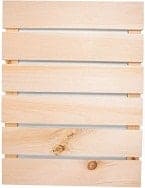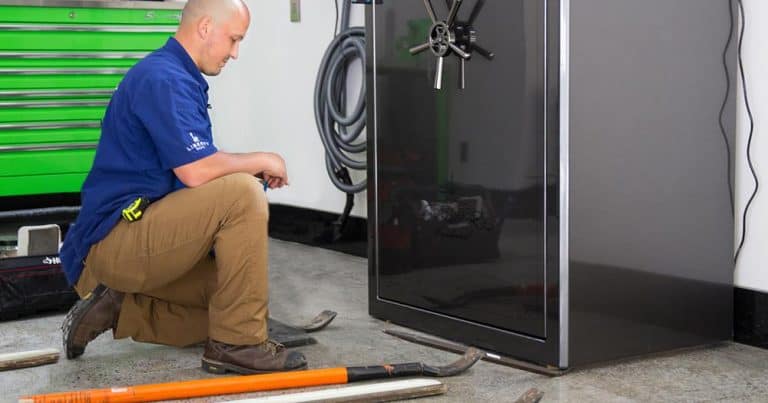For the average firearm enthusiast, the purchase of a quality gun safe is among the most valuable investments that can be made. A gun safe protects firearms and ammo from burglars, as well as from the scorching temperatures that arise in the event of a house fire.
This provides one with peace of mind, knowing that their firearm collection will be preserved for decades to come.
However, there is much more to gun safe ownership than simply making a purchase, and storing your firearms away. One must carefully consider how they intended to set up their gun safe, upon taking delivery.
If you intend to position your safe atop a concrete floor, additional thought must be put into what, if any, buffer material you intend to place beneath your safe’s base.
Table Of Contents
The Importance Of Elevation On Concrete
Many often question the importance of elevating a gun safe that is to be positioned on a concrete slab. After all, one would imagine concrete to be among the most hearty of surfaces that a gun safe could be placed upon.
While this is certainly true, a safe that is placed directly on concrete is prone to a host of troubling issues.
The vast majority of these issues relate to moisture and its effects upon metallic surfaces. Concrete sweats as a byproduct of natural heating and cooling.
This leads to the accumulation of moisture, to which a gun safe is exposed when placed directly atop a surface of this composition.
With time, and repeated exposure to moisture, metal begins to corrode. Rusting and pitting are two of the most common examples of corrosion, both of which can eventually comprise a gun safe’s structural integrity, and damage a safe’s contents with time.
To overcome such difficulties, many gun owners place various materials beneath their gun safes, in order to prevent direct metal-to-concrete contact. This poses two distinct advantages, over placing a safe directly upon a concrete slab.
The first such advantage is that a moisture barrier is created. This is especially true if such base-stock consists of material that is impervious to moisture.
While moisture will still form beneath this base-stock, its transmission to your safe’s metal surfaces is largely minimized.
The second advantage posed by the use of base stock, centers around an increase in available airflow. When a safe is elevated above floor level, with the use of shims, air flow is allowed to circulate beneath the vault’s base, thereby minimizing condensation-related moisture.
Simply put, a gun safe can be placed directly on top of a concrete slab. However, doing so is typically considered to be a bad idea.
Not only can such placement damage your safe, but it can also void the unit’s warranty, as the bulk of safe manufacturers do not cover structural defects related to corrosion.
What To Place Underneath A Gun Safe
One has several options to choose from when deciding what to place beneath their gun safe, to elevate it above ground level. Such base stock is often chosen based upon its availability, and overall ease of use.
The following are several of the most common materials placed beneath a gun safe on concrete.
Rubber Mats

Rubber mats are often placed beneath gun safes, due to their durability and natural water resistance. These mats are often composed of hard rubber, which does not easily compress, even when subjected to a relatively heavy load.
Many consumers use stall mats, such as those employed in equine operations, for this purpose. Alternatively, most hardware stores can custom cut industrial grade rubber from larger sheets, in order to suit one’s needs.
Wooden Boards

One simple way of elevating a gun safe on concrete is to use wooden boards. In most cases, wood is among the cheapest materials for use beneath a safe’s base and can be sourced from almost any hardware store.
However, one should be careful when selecting which type of wood to use. Since wood is not impervious to water, the use of treated boards is highly recommended.
Pallets

A pallet, such as those used in shipping, is often placed beneath gun safes on concrete surfaces. Due to the open construction of a pallet, air is allowed to flow in and around a safe’s base, further minimizing the risk of condensation-related water contamination.
However, one must also consider the overall weight of their gun safe, when determining whether or not a pallet is best suited for their particular application.
Shims

Specialty shims can be fashioned from a number of materials, allowing one to elevate their gun safe above the concrete surface on which it resides. These shims most often consist of wood, though other materials can be used in the same manner.
Alternatively, some consumers use pre-formed objects, such as hockey pucks or industrial-grade washers, for this same purpose. One is cautioned, however, that shims of a harder composition can actually damage certain surfaces, such as wood floors.
To Bolt Down, Or Not Bolt Down?
Some gun safe owners choose to bolt their vaults to the concrete below, while others do not. When closely studying such circumstances, there is a case for each school of thought, leaving one to decide whether or not solid-state securement is right for them, and their particular application.
Gun safe securement, via solid anchoring, substantially reduces the prevalence of flooring damage due to weight shift over a length period of time. Such securement also alleviates any fear of injury, at the hands of an overturned safe.
However, anchoring a safe in place requires permanent modification to a concrete surface. A concrete slab must be drilled with a hammer drill, before concrete anchors, anchor bolts, or lag bolts can be set in place.
If you anticipate moving your safe at some point in the future, securing your safe in this manner might be ill-advised.
One must also carefully study their floor’s composition before drilling of any type can take place. Post-tension concrete slabs are not to be drilled under any circumstance, as they feature high-tension cables running throughout their construction.
These cables are under thousands of pounds of pressure and can cause injury or death to bystanders if inadvertently damaged by a drill bit when bolting a safe down.
When bolting a safe down to a concrete surface, one should still consider employing the use of a moisture-resistant barrier. A rubber mat of sufficient thickness makes an excellent candidate for use beneath any safe that is to be bolted to a concrete surface.
Alternatively, epoxy can be applied to seal a concrete slab, before setting a safe in place.
Additional Countermeasures Against Moisture
Aside from elevating a gun safe above the concrete floor on which it rests, additional moisture-reducing countermeasures can be taken. All measures of this type are aimed at stifling the production of water that comes as the natural byproduct of condensation.
In order to accomplish such goals, many gun owners place desiccant cartridges within their gun safes. Desiccant naturally absorbs any airborne water molecules that are present within a confined space.
The use of such products has proven effective at keeping rust and other types of corrosion at bay.
A Golden Rod can also be used to prevent moisture from accumulating within a gun safe. This device slightly warms the air inside of a gun safe, thereby halting the natural heating and cooling process that occurs in any enclosed space.
This prevents water-producing condensation from occurring.
Most recently, a significant number of consumers have begun employing the use of electric dehumidifiers to keep their gun safes free of moisture. Units of this nature operate in a similar fashion to the Golden Rod, yet do not feature exposed heating elements.
Instead, a safe dehumidifier takes the form of a sealed unit, with an integrated control interface. These units are most often mounted at a central location along a safe’s floor or bolted directly to a safe door.
Protecting Your Investment
Even the best gun safe on the market is of little value if you do not take appropriate action to safeguard against rust and other forms of corrosion. Luckily, a gun owner’s fight against these destructive forces is easily won, with proper foresight and a bit of planning.
This includes determining whether or not to elevate your safe above ground level.
When placing a gun safe atop a concrete slab, the use of quality buffer material is highly advised. By placing base-stock beneath a gun safe’s base, you are not only preventing the transfer of moisture but bolstering air circulation as well.
As a result, your safe, as well as its contents, will be better protected for the long haul.
